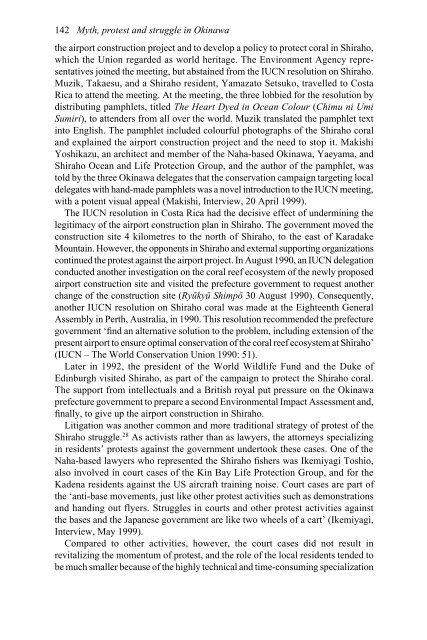Myth, Protest and Struggle in Okinawa
Myth, Protest and Struggle in Okinawa
Myth, Protest and Struggle in Okinawa
Create successful ePaper yourself
Turn your PDF publications into a flip-book with our unique Google optimized e-Paper software.
142 <strong>Myth</strong>, protest <strong>and</strong> struggle <strong>in</strong> Ok<strong>in</strong>awa<br />
the airport construction project <strong>and</strong> to develop a policy to protect coral <strong>in</strong> Shiraho,<br />
which the Union regarded as world heritage. The Environment Agency representatives<br />
jo<strong>in</strong>ed the meet<strong>in</strong>g, but absta<strong>in</strong>ed from the IUCN resolution on Shiraho.<br />
Muzik, Takaesu, <strong>and</strong> a Shiraho resident, Yamazato Setsuko, travelled to Costa<br />
Rica to attend the meet<strong>in</strong>g. At the meet<strong>in</strong>g, the three lobbied for the resolution by<br />
distribut<strong>in</strong>g pamphlets, titled The Heart Dyed <strong>in</strong> Ocean Colour (Chimu ni Umi<br />
Sumiri), to attenders from all over the world. Muzik translated the pamphlet text<br />
<strong>in</strong>to English. The pamphlet <strong>in</strong>cluded colourful photographs of the Shiraho coral<br />
<strong>and</strong> expla<strong>in</strong>ed the airport construction project <strong>and</strong> the need to stop it. Makishi<br />
Yoshikazu, an architect <strong>and</strong> member of the Naha-based Ok<strong>in</strong>awa, Yaeyama, <strong>and</strong><br />
Shiraho Ocean <strong>and</strong> Life Protection Group, <strong>and</strong> the author of the pamphlet, was<br />
told by the three Ok<strong>in</strong>awa delegates that the conservation campaign target<strong>in</strong>g local<br />
delegates with h<strong>and</strong>-made pamphlets was a novel <strong>in</strong>troduction to the IUCN meet<strong>in</strong>g,<br />
with a potent visual appeal (Makishi, Interview, 20 April 1999).<br />
The IUCN resolution <strong>in</strong> Costa Rica had the decisive effect of underm<strong>in</strong><strong>in</strong>g the<br />
legitimacy of the airport construction plan <strong>in</strong> Shiraho. The government moved the<br />
construction site 4 kilometres to the north of Shiraho, to the east of Karadake<br />
Mounta<strong>in</strong>. However, the opponents <strong>in</strong> Shiraho <strong>and</strong> external support<strong>in</strong>g organizations<br />
cont<strong>in</strong>ued the protest aga<strong>in</strong>st the airport project. In August 1990, an IUCN delegation<br />
conducted another <strong>in</strong>vestigation on the coral reef ecosystem of the newly proposed<br />
airport construction site <strong>and</strong> visited the prefecture government to request another<br />
change of the construction site (Ryūkyū Shimpō 30 August 1990). Consequently,<br />
another IUCN resolution on Shiraho coral was made at the Eighteenth General<br />
Assembly <strong>in</strong> Perth, Australia, <strong>in</strong> 1990. This resolution recommended the prefecture<br />
government ‘f<strong>in</strong>d an alternative solution to the problem, <strong>in</strong>clud<strong>in</strong>g extension of the<br />
present airport to ensure optimal conservation of the coral reef ecosystem at Shiraho’<br />
(IUCN – The World Conservation Union 1990: 51).<br />
Later <strong>in</strong> 1992, the president of the World Wildlife Fund <strong>and</strong> the Duke of<br />
Ed<strong>in</strong>burgh visited Shiraho, as part of the campaign to protect the Shiraho coral.<br />
The support from <strong>in</strong>tellectuals <strong>and</strong> a British royal put pressure on the Ok<strong>in</strong>awa<br />
prefecture government to prepare a second Environmental Impact Assessment <strong>and</strong>,<br />
f<strong>in</strong>ally, to give up the airport construction <strong>in</strong> Shiraho.<br />
Litigation was another common <strong>and</strong> more traditional strategy of protest of the<br />
Shiraho struggle. 28 As activists rather than as lawyers, the attorneys specializ<strong>in</strong>g<br />
<strong>in</strong> residents’ protests aga<strong>in</strong>st the government undertook these cases. One of the<br />
Naha-based lawyers who represented the Shiraho fishers was Ikemiyagi Toshio,<br />
also <strong>in</strong>volved <strong>in</strong> court cases of the K<strong>in</strong> Bay Life Protection Group, <strong>and</strong> for the<br />
Kadena residents aga<strong>in</strong>st the US aircraft tra<strong>in</strong><strong>in</strong>g noise. Court cases are part of<br />
the ‘anti-base movements, just like other protest activities such as demonstrations<br />
<strong>and</strong> h<strong>and</strong><strong>in</strong>g out flyers. <strong>Struggle</strong>s <strong>in</strong> courts <strong>and</strong> other protest activities aga<strong>in</strong>st<br />
the bases <strong>and</strong> the Japanese government are like two wheels of a cart’ (Ikemiyagi,<br />
Interview, May 1999).<br />
Compared to other activities, however, the court cases did not result <strong>in</strong><br />
revitaliz<strong>in</strong>g the momentum of protest, <strong>and</strong> the role of the local residents tended to<br />
be much smaller because of the highly technical <strong>and</strong> time-consum<strong>in</strong>g specialization
















